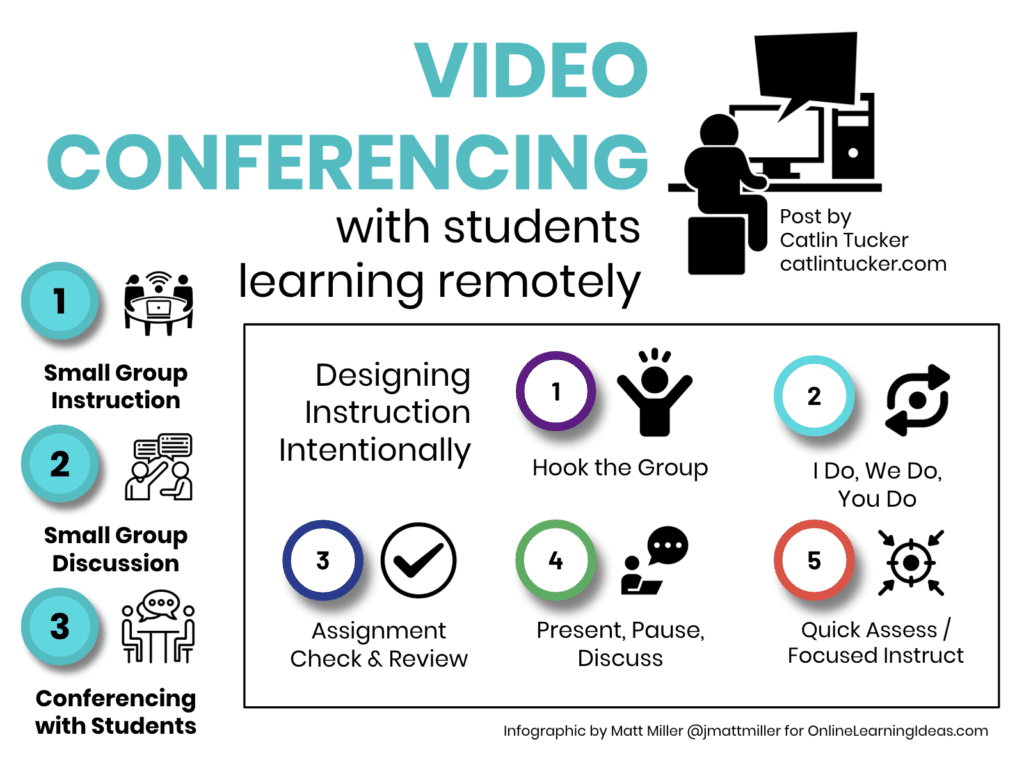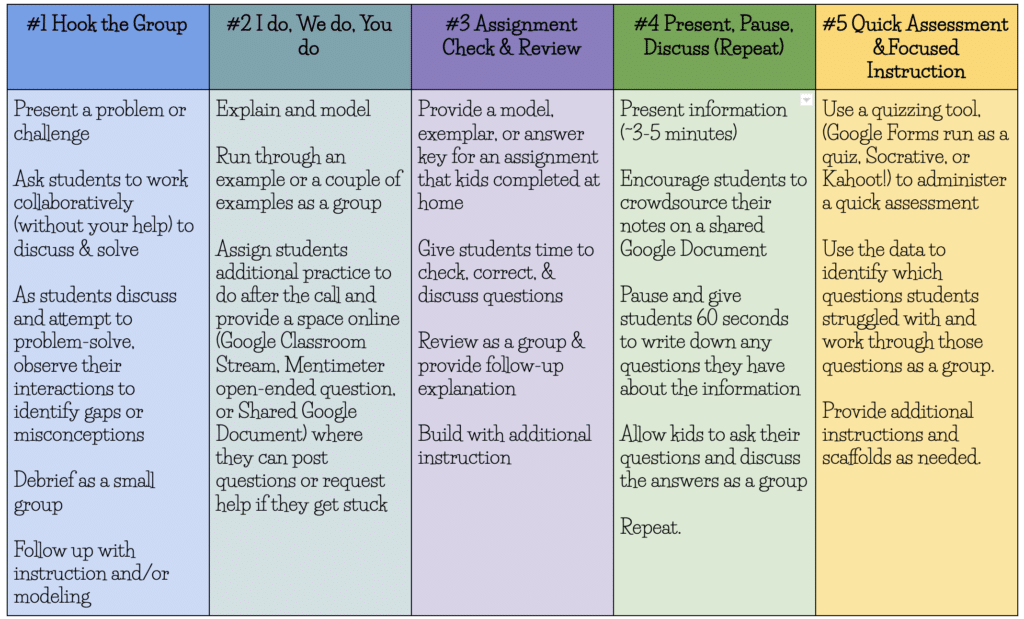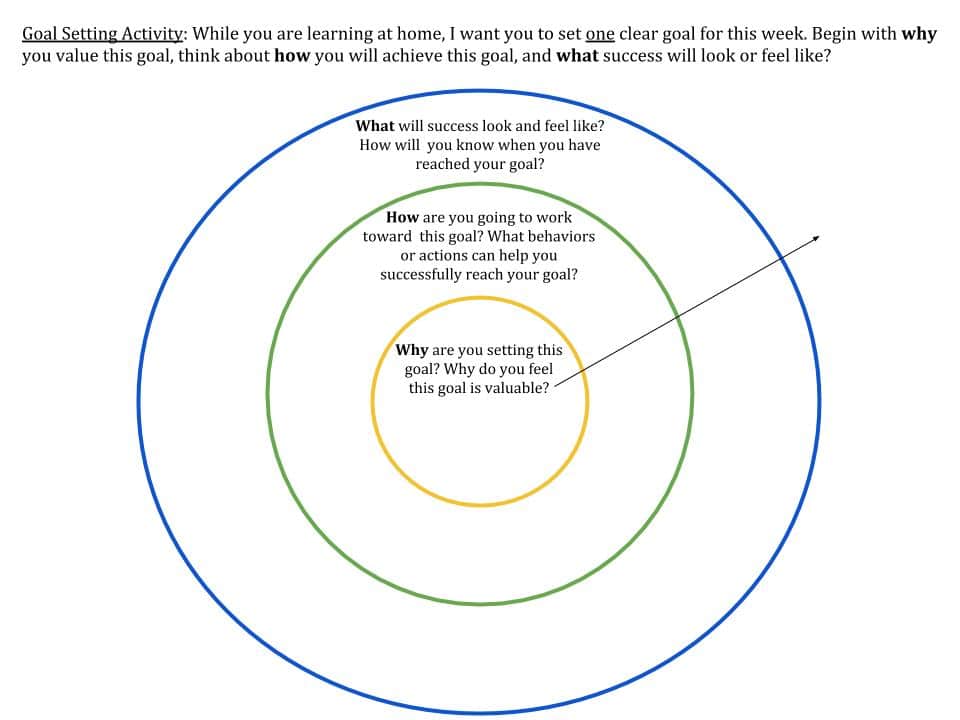Need support preparing for fall? Check out my self-paced online course Prepare for Fall 2020: Blended & Online Learning.
Thank goodness for Zoom and Google Meet! During this time of social isolation and remote learning, these video conferencing tools are lifesavers. They make it possible for teachers to maintain a human connection with their students and guide their learning from a distance. Below are three suggestions for using these video conferencing platforms to continue teaching students as they learn remotely.

#1 Small Group Instruction
Teachers can host a series of short Zoom or Google Meet sessions throughout the day focused on different skills or topics. These online sessions are an excellent way to continue teaching and connecting with learners. Even if teachers cannot require that students attend a live meeting due to concerns around access, connectivity, and availability, these sessions can be recorded and posted on class websites, Google Classroom, or a learning management system.
As teachers think about hosting virtual meetings, I would encourage them to approach the design of this time with intention. Structuring a small group instruction session will help to engage students and make the experience more meaningful for them. It is essential to build in time for them to discuss information and ask questions.

If teachers are planning to use video conference to simply transfer information (e.g., lectures or mini-lessons), I would suggest recording a video and allowing students to self-pace through that video. Then the valuable and limited time you have with students in a video conferencing session can be spent on more hands-on, collaborative, and engaging tasks.
#2 Facilitate a Small Group Discussion
Teachers can invite students to participate in a small group discussion about a chapter they read in a text or the textbook, debrief about a flipped video lesson, or unpack complex issues or topics related to your subject area.
Ideally, I would suggest teachers provide the discussion questions ahead of time to allow students to think about them before the conversation. I also recommend providing students with an online space where they can crowdsource and capture questions they would like to discuss. Teachers can do this using Mentimeter by asking an open-ended question, on a shared online document, or simply asking students to write down three questions on paper that they can bring to the conversation.

#3 Conferencing with Students
Conferencing online with students about their goals, progress, questions, and concerns is a powerful way to use video conferencing capabilities. Teachers can create a schedule of timeslots using an online calendar, like Google Calendar or Calendly, to allow students to sign up for 5-minute conferencing sessions.
I am a fan of using a goal-setting activity to guide conferencing sessions about student progress. In the past, I have used the SMART goal format to get students thinking about what they want to achieve in a grading period; however, given the fluid nature of the COVID-19 and school closures, I would encourage teachers to embrace goal-setting on a smaller scale (e.g., one week at a time).
I adapted Simon Sinek’s golden circle from his book Start with Why to get students thinking about why they want to achieve a particular goal (academic or personal), how they will go about achieving it, and what success will look or feel like.

Teachers can make a copy of the Google Drawing above and share it with students via Google Classroom. This goal-setting activity engages students in the metacognitive practice of setting a personal or academic goal at the start of each week. Then teachers can reference this goal during conferencing sessions. They can also end each week by asking students to reflect on their progress toward their goal that week in a journal or online reflective log.
Optional video conferencing sessions can offer students an avenue to connect and get the support they need during this tough time. I have also heard teachers on Twitter talk about offering parent Q&A sessions or coffee chats with families to keep them in the loop and lower anxiety levels. Other teachers are meeting with their professional learning communities (PLCs) to discuss lesson design, book study texts or education podcasts, or simply share what is working as they move curriculum online.
There are myriad ways to leverage video conferencing during this time of social isolation and remote learning. If you are using video conferencing with students, teachers, or families and want to share your approach, please take a moment to post a comment so we can learn from each other!


57 Responses
Hi
In small group, How many students each group?
Hi Fadhel,
Ideally, I would love anywhere from 6-10 students on a video call at a time.
Given that most of the remote learning happening cannot be mandated due to accessibility concerns, I would suggest offering a few short (15-20 min timeslots) and know that you may not get that many kids showing up.
Catlin
My district will not allow Zoom or Hangouts to be used with our 1/1 Chromebooks. Why? What is the restricting legal consideration? Could students abuse Zoom or Hangouts? I have been interested in live white boarding for small groups. One modeling teacher reported that she had to abandon the use of a site because inappropriate art that was fashioned on a student white board. Could something like this occur with Zoom or Hangouts? Is there a way to restrict the use of Zoom or Hangouts?
You can restrict students from scribbling on the whiteboard in ZOOM. Check out this option :
Annotation settings
If you started the shared screen or whiteboard, click More in the screen share controls for these annotation settings:
Allow/Disable participants annotation: Allow or prevent the participants from annotating on your shared screen.
Show/Hide Names of Annotators: Show or hide the participants’ name when they are annotating. If set to show, the participant’s name will briefly display beside their annotation.
credits : support.zoom.us
Do you have any guidelines/norms that you use with students for video conferencing? We are looking to use it and would love to know how other districts are handling protocols, parent permissions, rules, etc.
Hi Meg,
You may want to check out the simple graphic that Matt Miller designed to help students be successful on video calls in this blog–> https://ditchthattextbook.com/google-meet-elearning.
I cannot speak to district protocols, but I hope other folks can help to answer that question for you!
Catlin
Thank you so much for that link! Very helpful.
You’re welcome, Meg!
Take care.
Catlin
I found the above link to be very clear and informative. I am trying to open it again and it will not open. Could you send again?
Thank you,
Gail
Hi Gail,
What link do you need? I’m not sure which one you are trying to access.
Catlin
that link will not allow me to look at the content and I would love to see some digital norms.
Hi Atziri,
Their website was down temporarily because of high levels of traffic. I would check again in a day or two.
Catlin
very helpful info for organizing my thoughts
I think that this would be very beneficial. It gives the illusion of that small group, classroom setting, Yet, I think possibly making the student feel more comfortable in participating…..expressing themselves by being MORE vocal, asking questions when they would otherwise NOT do so.
I have solely worked with students 1:1 via video conferencing 1:1 for more than a decade and agree with a lot of your points. Reframing thing, preparation are key. I have a mini yoga session in sessions to help the students I support not get stiff especially useful for those who may have additional needs such as ADHD, dyspraxia/DCD, autism or dyslexia or suggest they get up and walk around to help concentration etc. My daughter, like me, has additional needs and has blossomed during GoogleMeets with teachers as she had much more control over the environment that usually distracts or distresses her.
My 15 year engaged more as she:
Asked questions via the chat box
Kept her camera turned off
The teacher gave a verbal answer to her typed question
Added useful links in the chat box
After a couple of weeks she began to ask questions via the microphone and would meet the teacher for a few minutes when everyone else had “logged off” to ask for any clarification or to show her work.
This flexibility really helped her.
This was helpful for me!
Material de trabajo importante para poder guiarnos
Gracias
Thank you very much for the tools. ITS really helpful. General lly it help to create learning community, facilitate learning and students feel comfortable to learn. Bravo
Hola,
I am a Spanish teacher and as you know many students dread learning a language. Might you have any resources/ideas on teaching Spanish virtually?
Thank you!!
Hi Maria,
I do not have any posts specific to teaching a foreign language, but you may want to check out Hyperdocs that have been tagged “Spanish” to see what other teachers are creating and sharing!
https://hyperdocs.co/search/node?keys=spanish
Take care.
Catlin
I live in Guanajuato, Mexico. I’m an English Teacher and it would be interesting doing an exercise with our students mine speak in English yours speak in Spanish? 40 minutes. I have false beginners, beginners and elementary students. From 10 to 13 years old. If you are interested let me know. Regards.
Have you ever considered Skype classroom that matches classes across the world. Many language teachers use it to enable pupils to practice their language skills with native speakers.
As a supervisor of student teachers, this was a perfect article to pass on, and the resource of Ditch That Textbook also fantastic. Thanks for supporting our teachers and learners.
It’s my pleasure, Diane!
Take care.
Catlin
There is also Microsoft Teams! Same kind of deal and works pretty similarly!
Just. beginning. This is going to be the future for kids, but they still need the feedback from educated adults for feedback. Happy to be learning along with the students.
I could not open the link for the graphic to help students be successful on video calls. Could you resend?
Hi Sharon,
It is the site. It is down. I’m sure it is temporary. I’d give it a few hours or a day or two and check again. Sometimes when a website experiences high levels of traffic, it can experience temporary issues.
Catlin
I was using Zoom but we had students that were using it for personal use. Any ideas on keeping our kids safe and still use video conferencing? I asked about Google Hangouts but was told it was also to hard to “police” what kids are doing during down time. What is something we can use that we invite students but they can’t access it?
Hi Desirae,
Zoom just did a significant update to increase security, so that is what I would suggest. Now, students need a code to join, and the teacher manually “admits” them into the room. The teacher can mute everyone and has a control panel to see who is raising a hand or wants to unmute.
Anyone can indeed use Zoom, but I am not sure why that is an issue if students use it to connect socially.
Maybe other teachers have recommendations they can share!
Take care.
Catlin
I’m Bangladeshi English Language teacher. I along with my students greatly benefited by using this Apps at this crisis moments by keeping them at their respective home. I think this temporary method but very useful at this moment. So, I myself thankful to Google authority for giving us chance to encandle the society by using their ZOOM CLOUDS MEETING Apps.
Thanking Yours,
Azad,
Dhaka,
Bangladesh.
Caitlin,
Can I share your graphic on Video Conference Teaching on our district website, giving you credit, of course?
Thank you!!
Absolutely! Thanks for sharing it with your district, Erika!
Take care.
Catlin
Because participating in the remote learning cannot be mandated and because I have a small group to begin with, I am having a difficult time getting my students to participate; especially with digital conferencing. I LOVE the idea of connecting with them and would love suggestions on how to get them to come join by digital conferencing. I wonder if posting videos and allowing them to reply with videos will be the closest thing I will get to video conferencing with them at this time.
Hi Patti,
You could always host a session (knowing it is not mandated), record it, then post the recording and invite anyone who did not attend to reply to the recording. That sounds like a great way to engage with kids who want to connect online, but everyone would have access to the recording.
Catlin
Nice Infomation.
The rising globalization has majorly contributed to the growing demand for video conferencing solutions globally. The use of video conferencing increases work efficiency while reducing the overall costs associated with non-virtual meetings.
Our district was using Teams. What is the difference between Zoom and Teams and is one more secure than another? What about group size? Ease of use?
Hi Sheril,
I am not that familiar with Teams. I’ll post this. Hopefully, someone else who has used Teams can chime in.
Take care.
Catlin
The importance of video conferencing in education has increased due to its feature of group chat while learning. It is exactly the digitalized version of Group Studies. The benefit of this is students can study collectively, & moreover, doubts of students can also be solved collectively. It makes communication easy, it is a messaging solution for education, besides it is easier for the tutor to communicate while teaching, thus it is nothing different than the traditional/physical approach of learning.
Hi Catlin,
I love the idea of doing a weekly goal setting activity with my Grade 6 students. Do you have any examples of student goals? I know my students will need to view some examples before being able to recognize what they need to work on and how to put that information into a written goal.
The post mentions that they can pick either academic or personal goals. I would appreciate seeing examples of both.
Hi Sarah,
I only have access to the ones my 9th and 10th-grade students produced, though I have coached elementary and middle school teachers who make goal setting a regular routine.
Academic Examples:
This grading period I want to improve my analysis of quotes so that I am not summarizing the information but analyzing how it supports my claim.
I want to commit to reading every day for 25 minutes outside of school so I can stay on top of my reading for class.
I will use my Google Calendar to break down the steps for our sustainability project so that I can stay organized and not procrastinate.
Personal goals:
I will turn my phone off (or on silent) when I am working on homework so that I do not get distracted.
I am going to run with my sister every day after school for the next month to prepare for track tryouts.
I am going to commit to eating at least one vegetarian meal per week to cut down on meat since it is not great for the environment.
I hope that helps!
Take care,
Catlin
Hi Catlin,
Thank you for this post! It’s clear and easy to absorb. I’m creating (updating) an online course for educators developing distance education classes and would love to include your link. Would that be OK?
Diana Satin
Digital Literacy Specialist/Coordinator
https://www.sabes.org/
Yes, you are welcome to include a link in your course, Diana.
Take care.
Catlin
Are you recommending going through all five steps in the small group instruction or just one per video call?
Hi Jessica,
I recommend one strategy per session. 😊
Take care.
Catlin
Catlin, Thanks for sharing your blog. I love it. I’ve developed a system on pre- and post Zoom activities. I’d like to share to you my resources, since I so much like what you represent. https://www.vignetteslabs.com/webinars https://www.vignetteslabs.com/site/excite Let’s have a short call. Ray
Have you ever considered Skype classroom that matches classes across the world. Many language teachers use it to enable pupils to practice their language skills with native speakers.
Yes, I know a lot of teachers who have used Skype Classroom and enjoyed it.
Catlin
Hello,
Thank you for these great resources and ideas.
You’re welcome, Vetta!
Thank you so much for your insight.
Very interesting article! Yet, when it comes to distant learning, many variables should be taken into consideration. Some of which are the learner’s motivation on the online space within which they interact with a community of other learners, and the teacher’s role to maintain communication and boost learners ‘ interest to stay focused. Teachers also should bear in mind that the learners’ capacity of concentration in front of a screen does not exceed 10 minutes maximum, so in order to keep distant learning an enjoyable experience, teachers should be able to put on different caps to build human interaction virtually because after all behind those laptops and computers there are hole individuals not machines!
Thanks for the tips
These are excellent tips. I really enjoyed the link provided that helped students on Zoom sitch the textbook.
Thanks for the great artcle!
This enhances students’ ability to learn with the virtual drawings that they may view in addition to other ways of learning.
This is an an excellent article!!!